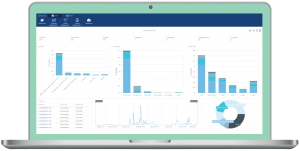One of the main reasons labs, Biobanks and biorepositories purchase a lab information management system (LIMS) is to improve data integrity and quality. Data management is a critical function of a LIMS. And crucially how you manage your data has a bearing on how, and if, you are able to use tissue samples. In this part of our ‘Make Every Sample Matter’ blog series we are underlining the important role data management plays in tissue sample selection and, ultimately, your samples’ usage.
Your data should help you find a sample, identify what is it and where it came from, understand what it can be used for (perhaps through its informed consent) and help you assess its viability. Without this information it’s unlikely a tissue sample will ever be used. And if you do use it, you may lack confidence in the ensuing test results.
And what could you be missing out on? Your data could tell you if a sample belongs to a family, what diseases the donor has, what treatments the donor has undergone and their lifestyle choices. You could be sitting on a goldmine of information that could really make a difference to research.
Data management isn’t a necessary admin chore – it’s protecting and enhancing a valuable asset
You might be surprised to learn that many labs and Biobanks still use spreadsheets to manage their data. And it’s not just the small labs and Biobanks. It’s labs and Biobanks of every size and complexity.

Spreadsheets are easy to set up and use but not so easy to manage or keep under control. Inconsistencies creep in. Not everything gets updated. Someone needs to hold additional information, so they create a new version. New tissue samples are created with the same reference numbers as existing samples. Or is it actually the same sample in a new storage location?
Consequently, you end up having sporadic ‘spring-cleaning sessions’ of your data. This can be time-consuming as well as demoralising. After all, you’ve got more important things to spend your time on.
And crucially, you’re not actually using and getting the most from your data. You’re just capturing it – sort of – sometimes. All of which you may see as a bit of a chore.
Implementing a LIMS won’t necessarily make data entry easier
Now it might sound like I’m completely contradicting myself, but nothing is as easy as entering whatever you want into a spreadsheet. There are no rules!
However, with laboratory information management system data management tools it’s much easier for you to find, update and understand your information. As a result, it’s easier to find, understand and work with your tissue samples. So, it will save you time and bring many other benefits.
As with any new system it may take some time for people to get used to it and, naturally, some people will adapt quicker than others. So, data entry won’t necessarily be easier but it will be better.
6 ways a LIMS can improve data quality
One the biggest benefits of using lab software to manage your data is the improvement in data quality. Improving data quality itself also leads to many other benefits such as increasing confidence in your results. Plus, it brings consistency across your services and processes which can improve overall quality which in turn leads to improved reputation.
There are 6 keys ways in which a laboratory information management system can help improve your data quality:
1. Data formatting
This includes making sure dates and numbers are correctly formatted. As well as providing you with a list of approved values to choose from when entering information.
2. Data validation
This checks that the values you enter are within the required parameters. Plus, it can ensure you enter critical data at the right point in the process.

3. Data standardisation and automated data entry
By using rules, formatting, automation and validation the system makes sure you are entering data consistently and in a standard way. As a result, it becomes much easier – and quicker – for you to search, access and analyse information.
4. Data integrity
Most LIMS are relational databases which means that there are links between records which the system maintains automatically. This allows you, for example, to set up one storage rack record and link many samples to it. The storage rack record exists once, so you don’t have to enter the same data multiple times. If you were using spreadsheets you would be re-entering the same storage rack information against each linked sample.
5. Data auditing
A lab information system provides an audit trail. This may include record changes as well as critical data updates and sample movements. So, you know exactly what has happened to a sample, when and by who. This is invaluable in helping you meet any regulatory compliance. Plus, it can help you assess a sample’s viability if you can see it’s been in and out of the freezer several times.
6. Data imports and integration
Some systems provide tools to import and transfer data from other systems and spreadsheets. They make sure you adhere to any validation and formatting rules. Importantly, this helps reduce manual errors and saves time by removing the need to rekey data.
Difference between a SQL Database and LIMS
It is true that both a SQL database and a LIMS support data management. Having said this there are two ways in which you can answer the question of a LIMS versus a SQL database (typically either SQL Server or Oracle).
Firstly, many laboratory information management systems use a SQL database to underpin the system and to hold and structure data. Achiever Medical also stores configuration details within its database tables. This allows for greater flexibility in terms of software changes and creates a more dynamic system.

Alternatively, it could be seen as the difference between building your own system and having a system that’s already been built, tried and tested.
In this scenario, a SQL database will help standardise and format your data. It’s a blank canvas where you create the tables and columns and define any rules and links between records. In addition, you have to consider searching for records as well as how you are going to control access and permissions.
Whereas LIMS offer core functionality to capture and audit your lab, donor and tissue sample data. Plus, they can automate your lab workflows. The software may already include many of your critical processes ‘out-of-the-box’ and have auditing and searching capability built-in. And it will also include security and permission options along with some predefined user roles.
In addition, the software may also include data migration, integration and dashboard capabilities. And with many enhanced systems you can configure them to match your exact requirements.
Data management in Achiever Medical LIMS
Achiever Medical LIMS data management tools give you everything you need to format, standardise, audit, search and analyse your data. Its standard lab and sample management workflows automate your lab processes. Plus, they prompt you to enter data at critical points in your processes as well as automatically enter repetitive data. All this helps make sure you don’t miss anything.

Its comprehensive record- and field-level auditing gives you complete traceability of what data has been changed, by who and when. In addition, the system automatically creates an audit trail of everything that has happened to a sample including whether it’s been moved or processed. Plus, the sample family tree shows a complete hierarchy with details of sample aliquots and derivatives created. Each sample is allocated a unique reference by the system to avoid any confusion.
With improvements in your data quality, you’re now in a position to use it to improve your data analysis, lab management and quality control. Achiever Medical’s real time dashboards can help you spot trends, identify issues in advance, highlight non-compliance and monitor productivity. All of which helps you improve the way your lab operates.
Achiever Medical’s enhanced donor and sample profiling capabilities allow you to build an in-depth picture of your donors and samples. As a result, you’re able to search for exactly what you need for your research. And because you’re entering data consistently and in one place, finding exactly what you’re looking for becomes a lot easier.
Achiever Medical web based LIMS solution gives you data management tools that help you ‘Make Every Sample Matter’.

Comments are closed.